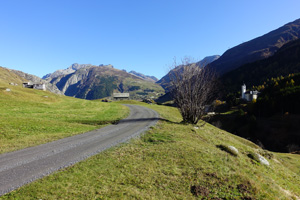 Andermatt is not the prettiest Swiss village. Certainly not the most famous or even otherwise particularly notable in a country positively littered with gorgeous little alpine towns straight out of a kitschy re-make of Heidi. It had been an important trade post along the route connecting Milan and Zurich, Italy, and much of north-western Europe. It had been a coveted holiday spot, especially for the English; Queen Victoria hung out incognito and Thomas Cook bundled groups of tourists there – the company’s first international destination package. The rail tunnel built in 1882 took care of most of that: trade went below-stairs and tourists all the way to Italy. Andermatt was then saved from obscurity (and poverty) by the Swiss military, which made it one of the centers of its Réduit defensive military concept of retreat to the mountains and denial of the strategic North-South passes and tunnels. The end of the cold war in 1990 took care of most of that. Andermatt was now left without trade, tourism, or the military, by then the largest local employer.
Andermatt is not the prettiest Swiss village. Certainly not the most famous or even otherwise particularly notable in a country positively littered with gorgeous little alpine towns straight out of a kitschy re-make of Heidi. It had been an important trade post along the route connecting Milan and Zurich, Italy, and much of north-western Europe. It had been a coveted holiday spot, especially for the English; Queen Victoria hung out incognito and Thomas Cook bundled groups of tourists there – the company’s first international destination package. The rail tunnel built in 1882 took care of most of that: trade went below-stairs and tourists all the way to Italy. Andermatt was then saved from obscurity (and poverty) by the Swiss military, which made it one of the centers of its Réduit defensive military concept of retreat to the mountains and denial of the strategic North-South passes and tunnels. The end of the cold war in 1990 took care of most of that. Andermatt was now left without trade, tourism, or the military, by then the largest local employer.
Understandably keen on a future, in the early Oughts the village of roughly a thousand inhabitants looked for advice from consulting investor Samih Sawiris. Sawiris, a Coptic Christian (no doubt to the relief of the Minaret-challenged Swiss) took a good look and, with apologies to Irving Berlin, asked himself what’s the best thing for them. And he and himself seemed to agree, that the best thing for them would be he. “Think big,” he told them, and founded the “Andermatt Swiss Alps” project, a real estate company and a reliable source for press junkets such as I attended. Sawiris built a massive five-star hotel, expanded the reach of the skiing area, had a highly rated golf course fashioned in the valley, and is now developing a whole new village on the other side of the Reuss river, the bridgehead of which is a massive Radisson hotel. And within the Radisson lies the reason you are reading about this, because the hotel also includes a location that started out life as a planned convention hall only to be diverted, adapted, and transformed into a concert hall. Samih Sawiris loves classical music.
A concert hall needs filling with music, which is where the brand new Andermatt Music Festival comes in. Three concerts, on this inaugural occasion: A recital, a chamber, and an orchestral concert, all in tepid association with the Lucerne Festival which bestows upon it the seal of artistic competence. Known quantities, too: Gabriela Montero as the recitalist, Benjamin Grosvenor & Strangers as the ensemble, and finally Daniel Harding and the European Chamber Orchestra as the orchestral cherry on top. Promising enough to accept the invitation to come, listen, and provide publicity.
The trip from Zurich toward and then along Lake Zug, Lake Lucerne, into the Reuss valley past Erstfeld, Silenen, Gurtnellen, Wassen, and finally Goeschenen, is particularly pretty; the final 1100-foot climb up the Schöllenen gorge, past the Devil’s Bridge to Andermatt at 4700 feet, very impressive. The same cannot be said of the first half of Gabriela Montero’s recital.
There’s something particularly dispiriting about modest Mozart. Played with one color, a narrow dynamic band, and two general tempos (fast while rushing and slow while indulgent), Sonata K. 330 did not fare well before the small audience. Perhaps Mme. Montero felt uncomfortable playing to the pitch-black auditorium (the light was later adjusted – after all, this is still very much the festival’s guinea-pig phase), but that couldn’t alone explain the breathlessness, the insecurities, the sewing-machine qualities of the Allegretto, or the oddly interjected romanticism in the Andante cantabile. Beethoven’s Waldstein sonata was fast and rushed again, to the point of hammered absurdity, and with lapses. The creeping slow movement was of the other extreme, but not better for it. It sent shivers down my spine – unless that was the air conditioning that cooled the room down a bit too thoroughly.
The ruminating Brahms Intermezzi Op. 117, partially in aquarelle colors, partially lullaby-esque, worked better after intermission, but the high point of a Montero recital is rightly the improvisation element for which she is best known. Famous arias and suggestions from the audience – favorite Swiss folk-tunes “Zogä-n-am Bogä” and “Vo Lozärn gäge Wäggis zue” – went through the Montero improvisation mechanics, which is to say that before long they sounded either like Bach or an Italian opera aria. It’s a most entertaining bit of her gigs, and the most impressive part was that she got half a hall of Swiss locals to sing (and quite well, actually) local tunes of some complexity to her – until she had internalized them sufficiently. Suddenly an audience of scarcely 150 sounded and felt like a filled hall, with heightened spirits, and the Mozart kindly forgotten.































